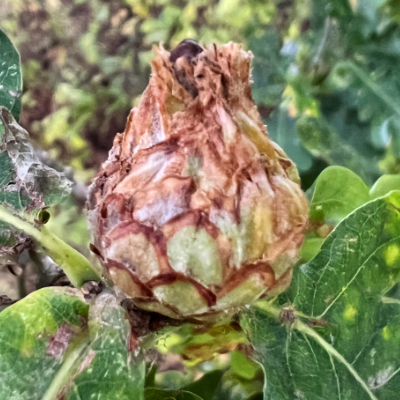
 |
|
Scientific Classifications explained » Amphibians » Ants » Aphids » Bees » Beetles » Birds » Bugs » Butterflies » Caterpillars » Damselflies » Dragonflies » Earwigs » Flies » Frog/Leafhoppers » Fungi » Galls » Grasshoppers » Harvestmen » Hoverflies » Lacewings » Ladybirds » Leaf Mines » Lichens » Mammals » Millipedes » Mosses » Moths » Sawflies » Slugs » Snails » Spiders » Trees & Shrubs » Wasps » Wild Flowers » Woodlice » Postboxes |
UK Nature > Galls > Oak Artichoke Gall

Gall causer: Andricus foecundatrix Common Name: Oak Artichoke Gall The oak artichoke gall is an abnormal growth on oak trees, primarily on pedunculate (Quercus robur) and sessile (Quercus petraea) oaks, caused by the gall wasp Andricus foecundatrix. The gall resembles an artichoke or a hop cone and forms in the oak's terminal or axillary leaf buds. This gall is the result of the asexual generation of the wasp, which emerges in the spring, lays eggs in catkins, and produces the subsequent sexual generation of wasps. The wasps emerging from the oak artichoke galls will be female; and these females will go on to lay a solitary egg in the male flowers of the oaks, which will cause the formation of the 'hairy catkin galls.' The flies that arise form these galls are of both sexes and the cycle then starts again after they have mated and eggs are laid in the oak buds. Once the oak artichoke gall has fallen to the ground the imago may leave the gall in the following spring, or may delay the emergence for 2–3 years. Galls may persist and exhibit opened scales curving outwards. |
|

https://www.uknature.co.uk is a website dedicated to showing the immense diversity of UK nature and wildlife. Our vast range of habitats, from lowland arable to snow covered mountains, from storm-ravaged coastlines to peaceful inland freshwater lakes and rivers, from dry, sandy heaths to deciduous and coniferous forests, all these habitats contribute to the abundance of UK nature. We have wild birds in huge numbers either residing or visiting our shores (597 recorded species as at July 2013) and we must also not forget the humble back garden with its grass lawns, flower beds filled with nectar rich flowers, shrubs and trees, all designed to attract huge numbers of insects such as bees, moths, butterflies and hoverflies; and finally the small ponds which provide safe havens for frogs, toads, newts and even slow worms and grass snakes. www.uknature.co.uk is the showcase for my personal passion, photographing uknature in all its glory. I sincerely hope you all enjoy the fruits of my labours. This site and all images contained therein is © Jeremy Lee 2004 - 2025. All Rights Reserved. Site design by Jeremy Lee. Site development & IT Support by Stuart Lee. |